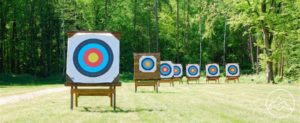Mastering the art of archery requires a meticulous and systematic approach, blending physical precision and mental focus. In this comprehensive beginner’s guide, we will delve into the essential steps for achieving accuracy and skill in archery. By juxtaposing the foundational basics of archery, the techniques and form required for success, and the importance of community and resources, this guide aims to provide aspiring archers with a comprehensive roadmap to navigate their archery journey.
The article will begin by exploring the fundamental aspects of archery, including establishing the correct stance and properly nocking the arrow. We will then delve into the techniques and form necessary for consistent and accurate shots, emphasizing factors such as grip, posture, alignment, and aiming methods. Additionally, we will highlight the significance of evaluating and correcting one’s shot, along with the importance of regular practice to enhance form and proficiency. Finally, we will underscore the benefits of joining the archery community, which provides valuable resources and support for beginners seeking to refine their skills. By following this beginner’s guide, aspiring archers can lay a solid foundation for mastering the art of archery.
Key Takeaways
- Stance: Beginners should focus on either a squared stance or an open stance.
- Proper grip: It is important to rest the bow on the pad of the thumb and avoid squeezing too hard.
- Anchor point: Develop a consistent point of reference on the face to ensure accuracy.
- Practice and improvement: Regular practice is essential to becoming a skilled and accurate archer.
Basics of Archery
The basics of archery, including stance, nocking, bow grip, and posture and alignment, are essential for beginners to master in order to achieve success in the sport. Choosing the right equipment is crucial for a beginner archer. This includes selecting the appropriate bow and arrows based on factors such as draw weight, draw length, and personal preference. Proper arrow selection is also important, as it affects accuracy and consistency. Factors to consider when choosing arrows include spine stiffness, length, and weight. Additionally, beginners must learn the proper technique for nocking the arrow onto the bowstring and gripping the bow correctly. Posture and alignment are equally important, as they ensure a stable and consistent shooting form. Mastering these basics lays the foundation for a successful archery journey.
Techniques and Form
Techniques and form are essential components to becoming a proficient archer. Developing proper technique and form is crucial for improving accuracy and avoiding common mistakes. One common mistake is improper stance, where beginners may have a squared or open stance instead of maintaining a balanced and aligned body position. Another mistake is gripping the bow too tightly, which can affect the release and accuracy of the shot. Additionally, failing to anchor consistently can lead to inconsistent shots. To improve accuracy, archers should focus on maintaining a straight torso, aligning their collarbone parallel to the target, and keeping their release-hand elbow up. By practicing these techniques and paying attention to form, beginners can enhance their archery skills and achieve greater accuracy in their shots.
Community and Resources
Joining the archery community provides valuable resources and opportunities for skill development, allowing individuals to connect with other enthusiasts and access exclusive content. Joining archery clubs can offer a supportive environment where beginners can learn from experienced archers and receive guidance on technique and form. These clubs often organize regular practice sessions and competitions, providing opportunities for individuals to refine their skills and measure their progress. Additionally, archery communities often provide access to online tutorials and instructional materials, which can be helpful for beginners looking to learn at their own pace or supplement their in-person training. Online forums and social media groups also allow archers to connect with others who share their passion and exchange tips and advice. Overall, becoming part of the archery community can greatly enhance a beginner’s journey towards mastering the art of archery.
Frequently Asked Questions
What type of bow is best for beginners?
When choosing a bow for beginners, it is important to consider the pros and cons of different types. Recurve bows are a popular choice as they are versatile and offer a traditional shooting experience. They require more strength to draw, but provide better accuracy. Compound bows, on the other hand, have a higher draw weight but offer a let-off point which reduces the holding weight. Ultimately, the right bow for you will depend on your body type and shooting style.
How long does it take to become proficient in archery?
Becoming proficient in archery requires time and dedication. The duration varies depending on individual factors such as natural ability, practice frequency, and coaching. On average, it can take several months to a year for beginners to achieve proficiency. To enhance accuracy in archery competitions, it is crucial to select the right arrow for your needs. Consider factors such as arrow material, spine stiffness, and weight. Additionally, practice regularly, focus on proper form and technique, and seek guidance from experienced archers or coaches.
Are there any specific exercises or stretches that can help improve archery skills?
To improve archery skills, there are specific exercises and stretches that can enhance aim and overall technique. Exercises such as shoulder rotations, scapular retractions, and core strengthening can help improve stability and control. Stretches targeting the shoulders, chest, and back can increase flexibility and range of motion. Additionally, practicing proper form and technique, focusing on alignment, anchor points, and follow-through, can greatly enhance archery skills and accuracy. Regular practice and consistency are key to mastering the art of archery.
What are some common mistakes that beginners make and how can they be avoided?
One common mistake beginners make in archery is having improper stance and alignment. For example, standing with an open stance instead of a squared stance can affect balance and accuracy. To avoid this mistake, beginners should focus on maintaining a square stance and aligning their body properly. Additionally, beginners often struggle with releasing the bowstring too quickly or forcefully, which can lead to inconsistent shots. By practicing a smooth and controlled release, beginners can improve their accuracy and overall archery skills.
Are there any safety precautions or guidelines that beginners should be aware of when practicing archery?
Safety precautions in archery: Key guidelines for beginners include essential safety measures for novice archers. It is crucial for beginners to follow certain precautions when practicing archery. Some important safety tips for beginners include maintaining a safe distance from others, ensuring a clear shooting range, and wearing proper protective gear such as arm guards and finger tabs. Additionally, beginners should always handle their equipment with care, never point arrows at people, and be aware of their surroundings to avoid accidents or injuries.
Conclusion
In the intricate dance between archer and bow, mastering the art of archery requires patience, precision, and perseverance. This beginner’s guide has illuminated the 11 essential steps to success, from establishing the right stance to perfecting aim and follow-through. Like a skilled painter with a brush, the archer must carefully craft each shot, considering form, technique, and alignment. With regular practice and a supportive community, the archer’s journey becomes a tapestry of growth and skill. So, take up your bow, embrace the challenge, and let your arrows soar towards mastery.












